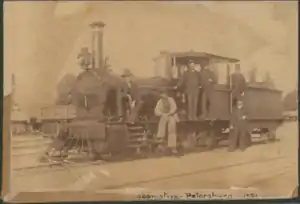South Australian Railways U class
The South Australian Railways U Class Locomotives were the first built by Beyer, Peacock and Company in 1876 for the South Australian Railways narrow-gauge lines.[1]
| South Australian Railways U Class | |||||||||||||||||||||||||||||||||||
|---|---|---|---|---|---|---|---|---|---|---|---|---|---|---|---|---|---|---|---|---|---|---|---|---|---|---|---|---|---|---|---|---|---|---|---|
 South Australian Railways U Class Locomotive No. 2 | |||||||||||||||||||||||||||||||||||
| |||||||||||||||||||||||||||||||||||
| |||||||||||||||||||||||||||||||||||
| |||||||||||||||||||||||||||||||||||
| |||||||||||||||||||||||||||||||||||
History
When horses proved unsatisfactory on the narrow gauge lines, particularly the Port Wakefield-Hoyleton and Port Pirie-Crystal Brook lines, it was decided to introduce steam traction, resulting in eight engines being imported from Beyer, Peacock and Company. These 2-6-0 type locomotives were the first to work on the South Australian Railways narrow gauge system, an extensive one in the early part of the twentieth century. On arrival from England the locomotives were assembled, with four allocated to Port Pirie and the remainder to Port Wakefield. In addition to their regular operations, several were used by contractors from time to time in the work of extending the narrow gauge further into the hinterland. As heavier locomotives became available to handle additional traffic, the U class engines were used for shunting duties in the areas they helped to develop. Some were later diverted to the Port Lincoln Division, where they served until withdrawal.[2]
References
- Drymalik, Chris. "Narrow Gauge U-class 2-6-0 locomotives". Chris's Commonwealth Railways Information (ComRails). Retrieved 1 August 2019.
- Fluck, R. E.; Sampson, R.; Bird, K. J. (1986). Steam locomotives and railcars of the South Australian Railways. South Australia: Mile End Railway Museum (S.A.) Inc. p. 112. ISBN 0959 5073 37.